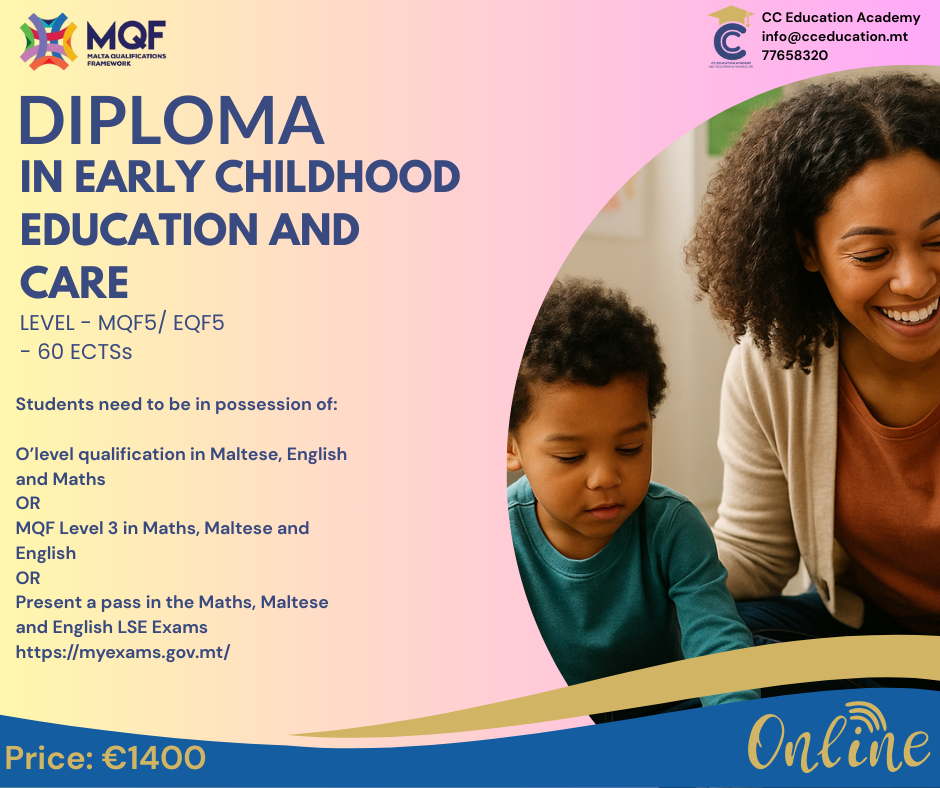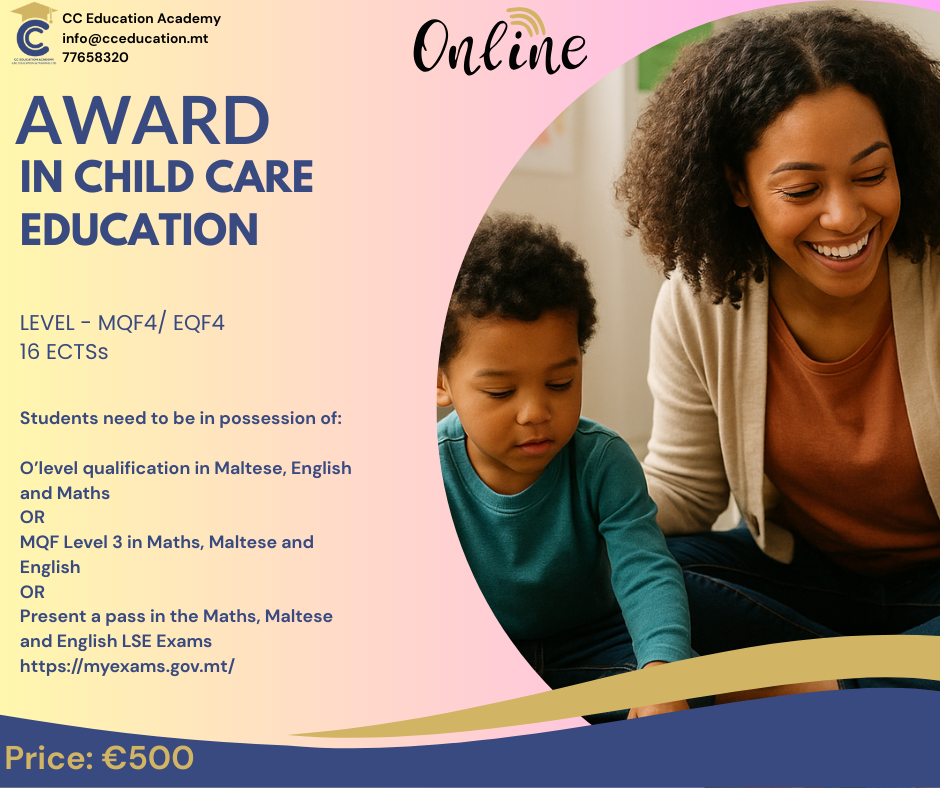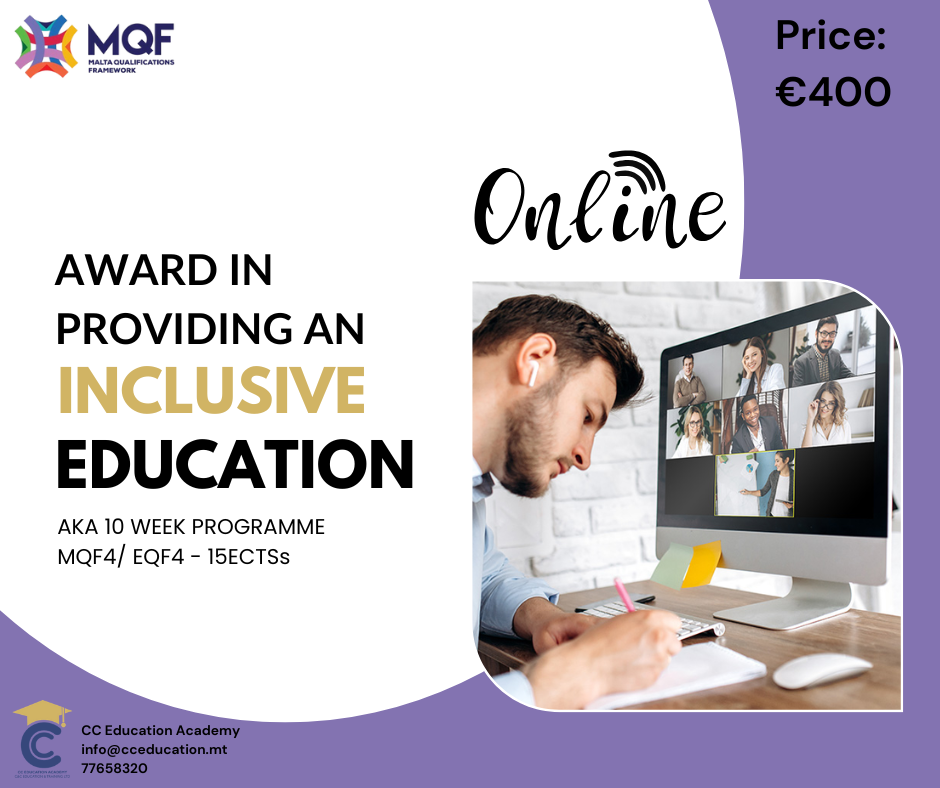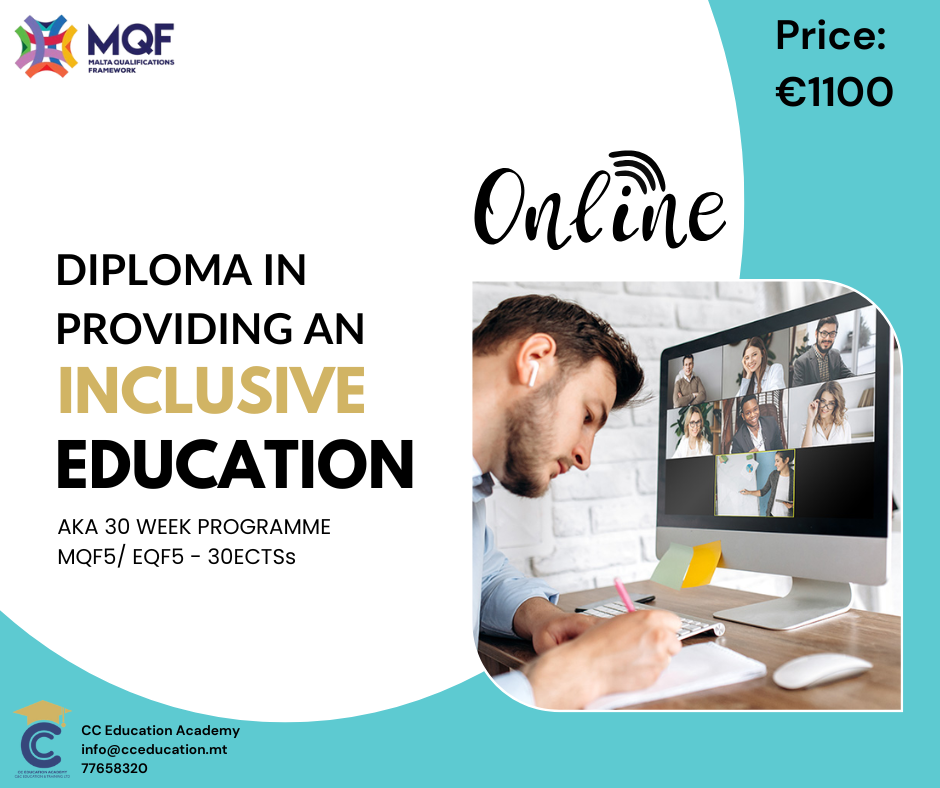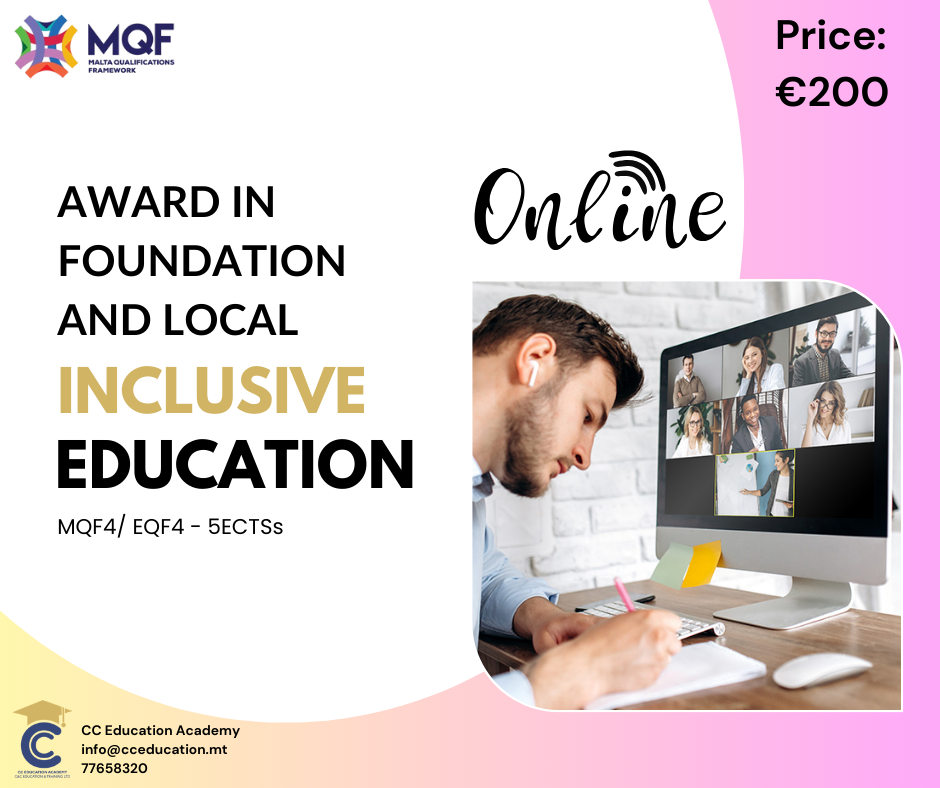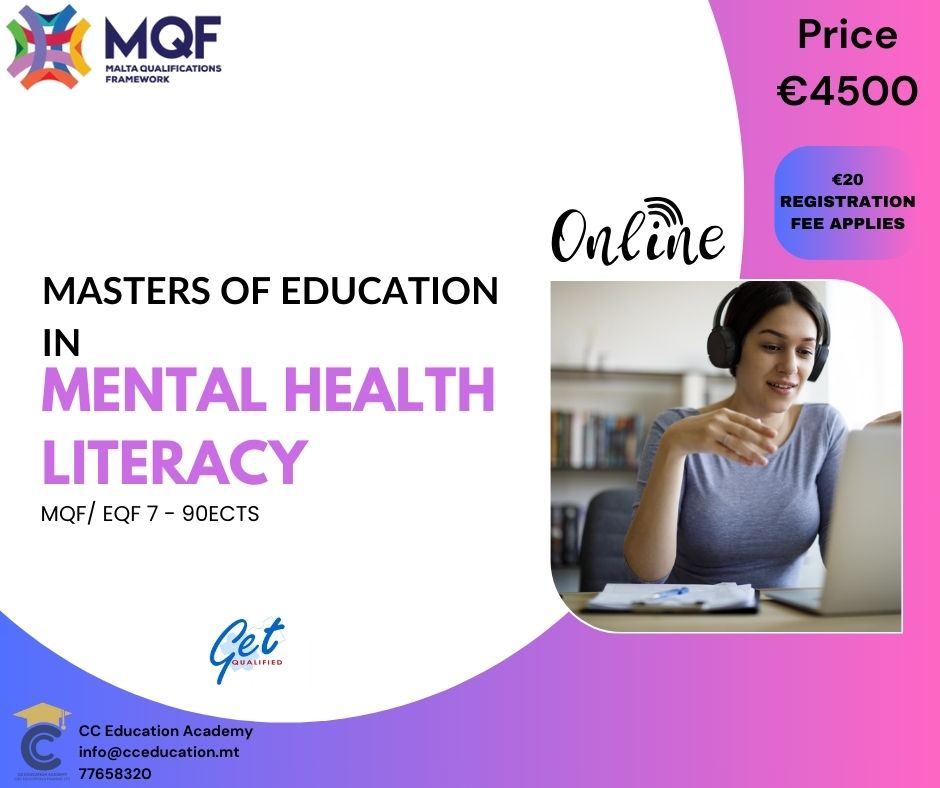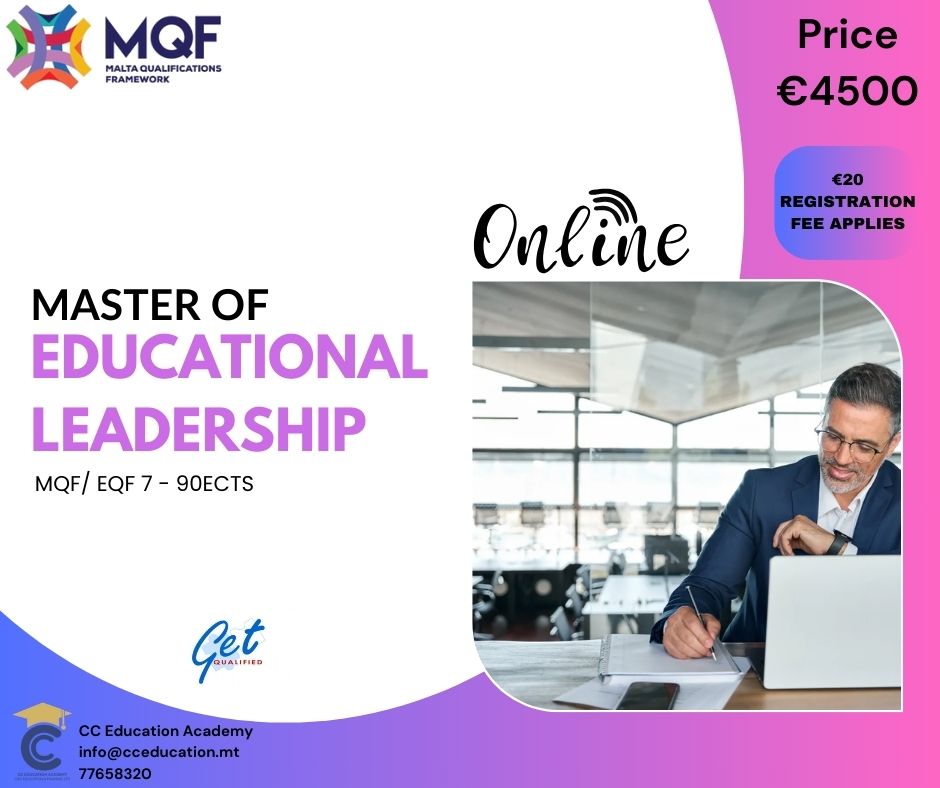CC Education Academy
Licensed as a Further and Higher Education Institution by the MFHEA
Licence no. 2022-019
The Programme
This course provides a deeper understanding of the core competences in the field of inclusive education. It aims to give further knowledge on the diverse needs, as well as to introduce different teaching techniques and the theories of learning. It is aimed for those individuals who would like to further pursue a career within the field of inclusive education and work as a Learning Support Educator. It is a follow up course and is open to learners who have already acquired the Award course award (MQF Level 4)
Course Content
Child Development – the Theoretical aspect
3ECTSs (equivalent to 75 total hours, which include self study and assessment hours)
Mode of delivery: Online Lectures, Forum Discussion, Reading
This module gives an overview of the studies on child development. It aims to give a general view of the sequential milestones and the theories that five main developmental theories. The module further delves in the role of a LSE, as adults and educators, in assisting the children’s holistic development
Assessment methods: 20% Forum Participation and 80% assignment
Learning Theories (1)
3ECTSs (equivalent to 75 total hours, which include self-study and assessment hours)
Mode of delivery: Online Lectures, Forum Discussion, Reading
This module focuses on the theoretical aspects of learning. It aims to introduce learners to the three main learning theories and to further delve into the implementation of such theories in classroom situations.
Assessment methods: 20% Forum Participation 80% Project
The role of the different support services
3ECTSs (equivalent to 75 total hours, which include self study and assessment hours)
Mode of delivery: Online Lectures, Forum Discussion, Reading
This module aims to give a sound knowledge of the different services available. It aims to make the students aware of the Educational Psycho-Social Services and the Inclusive Education Support Services, available at the NSSS. Moreover, the module also aims to create an understanding of the referral and assessment procedures that are currently practiced locally.
Assessment Methods: 20% Forum Participation and 80% Project
Understanding challenging behaviour
3ECTSs (equivalent to 75 total hours, which include self-study and assessment hours)
Mode of delivery: Online Lectures, Forum Discussion, Reading
The aim of this module is to provide the learners with the skills and abilities to address challenging behaviours at school. It also provides different strategies and behavioural plans that can be used in classrooms. In this module, the learners also gain more knowledge of modern studies in the theoretical field of behaviourism, as well as ways on how to implement Restorative Justice in schools.
Assessment Methods: 20% Forum Participation and 80% Project
Numeracy and Literacy in the classroom – An introduction
3ECTSs (equivalent to 75 total hours, which include self-study and assessment hours)
Mode of delivery: Online Lectures, Forum Discussion, Reading
This module presents different methods and techniques on how to teach numeracy and literacy skills. It aims to introduce learners to different methods of delivering lessons, with specific reference to differentiation and scaffolded instruction.
Assessment Methods: 20% Forum Participation and 80% Project
Addressing communication difficulties
3ECTSs (equivalent to 75 total hours, which include self study and assessment hours)
Mode of delivery: Online Lectures, Forum Discussion, Reading
This module focuses on speech, language, and communication difficulties. Active listening and good communication skills are discussed. It also aims to give knowledge on the different communication difficulties and offer ways on how to effectively use and promote communication technology and strategies. The role of the speech pathologist and the ACTU is also explored in some detail.
Assessment Methods: 20% Forum Participation and 80% Multiple-choice Question Test
Practice Placement
12ECTSs (equivalent to 300 total hours, which include self-study and assessment hours)
Mode of delivery: Practice Placement at school
This module allows learners to put to practice what the skills, knowledge, and competence that they have acquired at the workplace. Learners will have to meet a set of learning outcomes and demonstrate ability to work with students and carry out the tasks required from an effective and successful LSEs.
Assessment Methods: 20% Online interview, 60% Preparation of file and 40% Visits
General Information
Course delivery: ONLINE
Course duration: Between 22-24 weeks on a part time basis only
Date of next intake: Periodically - Interested students are to register their interest and be contacted once another intake is announced
Language of Delivery: English/ Maltese
Placement hours: 165hrs
Price: €950 + €20 registration fee
Total Hours (which includes self-study and assessment hours calculated according to the MFHEA guidelines) - 750hrs
Entry requirements
In possession of the Award in Providing an Inclusive Education (MQF 4)
Target Audience
The course is designed for learners who are already in possession of the Pre-Tertiary Certificate in Inclusive education (MQF Level 4) and would like to pursue their studies in the field.
Grading
Learners must achieve a minimum score of 50% in each module to qualify for certification.
Student Success Rate
Up to date (March 2025), a 100% student success rate has been recorded. All students who have pursued this programme to the end have received their certification.
Learning Outcomes
Certificate in Providing an Inclusive Education – MQF5 – 30ECTSs
Part time – 22/24 weeks - 750hrs
(Please note that this Programme may be taken alone or as part of the Bachelors in Education Programme)
Programme Learning Outcomes
By the end of the programme, the learner will be able to:
Define physical, language, cognitive and emotional changes that occur during the child’s development
List and describe the five main learning theories and how they can be applied in the classroom
Identify and define the different services available to students who are experiencing any difficulties in their lives
Identify further ways on how to better accommodate the needs of the students, regardless of their strengths and needs
Describe ways of preparing adaptations in relation to numeracy and literacy tasks
Recall available services, including those that may further help the students to be included in society once they are no longer at school
Identify ways on how to address challenging behaviour in a classroom situation
Identify the different AAC solutions and how they can be used with students that are facing communication difficulties
Use their knowledge of the developmental stages and make sure that all students get a holistic education
Apply learning theories to aid the learning journey of the students
Demonstrate their knowledge of the different services and apply that knowledge to identify what the student needs
Use forum to discuss with other LSEs and tutors on subjects relating to inclusive education
Design and a plan to target behavioural difficulties
Apply their knowledge of communication devices to design inclusion for students with communication difficulties
Apply their knowledge of literacy and numeracy to design adapted work to accommodate students with learning difficulties
Module 1: Childhood Development – the theoretical aspect
Module Learning Outcomes
At the end of the module/unit the learner will have acquired the responsibility and autonomy to:
Create goals that meet with the developmental milestones
Ensure that all developmental areas of their students are given due importance
Create resources in line with the developmental theories to ensure that learning is kept relevant
Ensure that their students are given a holistic education
Identify the developmental stages
Identify the main principles of development
Describe the main findings of psychoanalytic theories, behaviourism, and social theories as well as the cognitive learning theory in relation to development
List the theories behind the different developmental areas
Define the importance of a holistic education
Describe the journey of the study of child development
Discuss how theories are relevant to their role as educators
Discuss as a group on how we, as adults, can accommodate the students’ development
Plan teaching material to accommodate different developmental areas
Apply effective techniques to identify students’ developmental needs, taking into consideration their present level
Design resources that are in line with the students’ milestones
Apply the knowledge of various child development theories to their practice, to assess and identify the following goals.
Research different sources to present an assignment that corresponds to the topic discussed
Discuss the topic at hand and specific difficulties on the forum, with tutors and peers.
Module 2: Learning Outcomes
Module Learning Outcomes
At the end of the module/unit the learner will have acquired the responsibility and autonomy to:
Create resources based on the theoretical findings of the theorists
Ensure that the goals of the resources meet the criteria of an evidence-based approach
Deal with challenges in class by applying the findings of different learning theories
Collaborate with school team to address their students’ difficulties
Ensure that the students’ ability is used to address the limitations
Identify the resources that can be associated with the theory
List different ways on how they can put the theories to practice
Name different theorists and their findings
Define the behavioural theory, and the different ways in which such findings can be applied in schools
Identify the different elements of the cognitive learning theories
Describe the relevance of the Social Learning Theory
Describe how the learning strategies used in schools are directly related to the different theories
Define how all theories have important implications, and can be implemented depending on the needs and response of their students
Practice evidence-based teaching
Design programmes to address or prevent behaviour difficulties
Design goals and resources according to the students’ needs, based on the learning theories
Create resources that are evidence-based according to theory
Use technology to create resources to address a developmental area in relation to a theory discussed
Module 3: The Role of Different Support Services
Module Learning Outcomes
At the end of the module/unit the learner will have acquired the responsibility and autonomy to:
Be responsible for suggesting the right professional assistance when they identify any specific needs in their teaching experience
Collaborate with different professionals involved
Create detailed reports on students to record their development
Recall the roles of different professionals involved
Name the areas of development that can be catered for the different professionals
Recall the referral procedure that is in place locally
Describe the steps needed to be taken prior to an official referral
Define the role and autonomy of the guardians in the involvement of other professionals
Recall ways to report for other professionals, making sure that the strengths of their students and given priority
Practice effective planning and development of reports and referrals in a professional manner
Communicate and cooperate with other professionals to offer continuation of the learning journey at school
Compose a coherent report that aims to give holistic profile and the specific strengths and needs
Demonstrate the ability to assess situations where other services may be needed
Prepare a typed report making use of digital software
Use electronic mail effectively to communicate with others
Module 4: Understanding and Addressing Challenging Behaviour
Module Learning Outcomes
At the end of the module/unit the learner will have acquired the responsibility and autonomy to:
Create different behavioural plans according to the needs of their students
Be responsible for monitoring and observing students’ behaviour and compile the ABC chart to identify the antecedent and the behaviour and analyse the resulting consequence.
Compile observation reports independently
Devise strategies that are in line with the principles of Restorative Justice
Be able to think critically about behaviour charts and intrinsic motivation
Recall the principles of restorative justice
Describe the importance of restorative justice practice in schools
Recall ways of approaching key people in the school that can assist in the implementation of restorative methods within and out of the school community
Identify strategies that address challenging behaviour
Recall ways of devising behavioural plans that are in line with theories discussed
Name main theories and studies that are associated with behaviour modification, and how to discern with what is beneficial to the child they are assisting
Identify common behaviour triggers
Evaluate the behaviours exhibited in schools
Plan strategies that are based on the theories for behaviour modification
Use good communication with their students to deal with unwanted behaviour
Eradicate the mentality that children’s behaviour makes them ‘good’ or ‘bad’
Discuss the importance of understanding the students’ needs to assess the behaviour
Apply their knowledge on behaviour modification to identify the students’ needs and possible triggers
Use different techniques related to behavioural modification
Assemble and present resources associated with behaviour modification
Use internet to prepare resources related to behaviour modification, such as visual charts and social stories
Module 5: Numeracy and Literacy in the Classroom –An introduction
Module Learning Outcomes
At the end of the module/unit the learner will have acquired the responsibility and autonomy to:
Monitor students’ progress in numeracy and literacy using the LOs
Ensure that the goal set for their students is relevant and achievable
Be responsible to put into practice differentiation and scaffolded instruction in the classroom
Create different resources and implement the required strategies to teach literacy and numeracy skills
Ensure that the objectives of the lessons are made clear to their students
Assess the output of the lessons they deliver in the classroom
Self-reflect on their performance as educators to the lesson delivered
Describe the meaning of differentiation and Universal Design of Learning
Identify the importance of scaffolded instruction
Describe ways of using LOs effectively in their classroom practice and IEP
Recall ways of using sequential goal setting in classroom
List different resources and strategies that can be used to target different goals in relation to numeracy and literacy skills
Practice strategies that target different learning goals
Practice scaffolded instruction and differentiation in the classroom
Apply their knowledge of the LOs to create goals
Create resources and adaptations to help their students reach different goals related to numeracy and literacy
Devise and implement strategies that target literacy and numeracy skills
Use applications and software to create resources that may be used in class
Module 6: Addressing Communication Difficulties
Module Learning Outcomes
At the end of the module/unit the learner will have acquired the responsibility and autonomy to:
Collaborate with other professionals to address the communication difficulties
Deal with situations where verbal communication is not present
Implement strategies to enhance their students’ communication skills
Model good communication skills
Name different needs in the areas of communication
Identify the elements associated with this area
Describe the role of the different professionals related to the field
Describe how to properly use different AAC devices
Name ways of using different strategies to improve student’s communication skills
List a number of communication strategies that can be used to target this area
Identify ways of communication and be aware of non-verbal cues
Identify and respond effectively to communication cues that might present themselves
Demonstrate their knowledge on the importance of the other professionals in enhancing the students’ communication skills
Practice good communication skills
Design strategies to enhance communication skills
Use AAC devices to communicate with their students when verbal communication is not yet developed
Plan and implement strategies to improve students’ communication skills
Self-reflect on their own communication skills
Use different strategies and resources with children to improve communication skills
Communicate with students using different communication media
Practice active listening and effective communication skills
Module 7: Practice Placement
Module Learning Outcomes
At the end of the module/unit the learner will have acquired the responsibility and autonomy to:
Collaborate with superiors and colleagues at the workplace
Carry out tasks provided by workplace successfully
Monitor behaviour of learners and tailor education experience for the requirements and needs of the learners
Attend to the needs of learners in an effective manner
Produce an effective portfolio portraying one’s work
Describe the importance of reporting and journaling throughout the practice placement
Write an effective portfolio including all required material and resources
List the strengths and requirements of the student in their care
Recall the types, causes and characteristics of various disabilities
List the requirements for high quality of inclusive education
Demonstrate ability to implement the methods and techniques learnt throughout the sessions at the workplace
Use knowledge acquired on disabilities to be cater for the needs of the student
Show knowledge on the diverse types of disabilities, and relevant strategies
Analyse their own learning and implement various strategies to accommodate and provide a tailor-made experience to learners in their care
Create resources that cater for their students’ needs
Form attachments with their students to enable a healthy learning environment
Create resources suitable for the child’s age and abilities.
Create activities that show creativity and innovation
Use the LSE toolkit created throughout the previous units
Communicate effectively with the tutors to discuss the placement
Keep track of the child’s progress according to the LO Framework
Create flashcards, power point presentations and worksheets
Design games and interactive activities that will fit in with the child and the topics learned at school
Please note that all payments are non-refundable
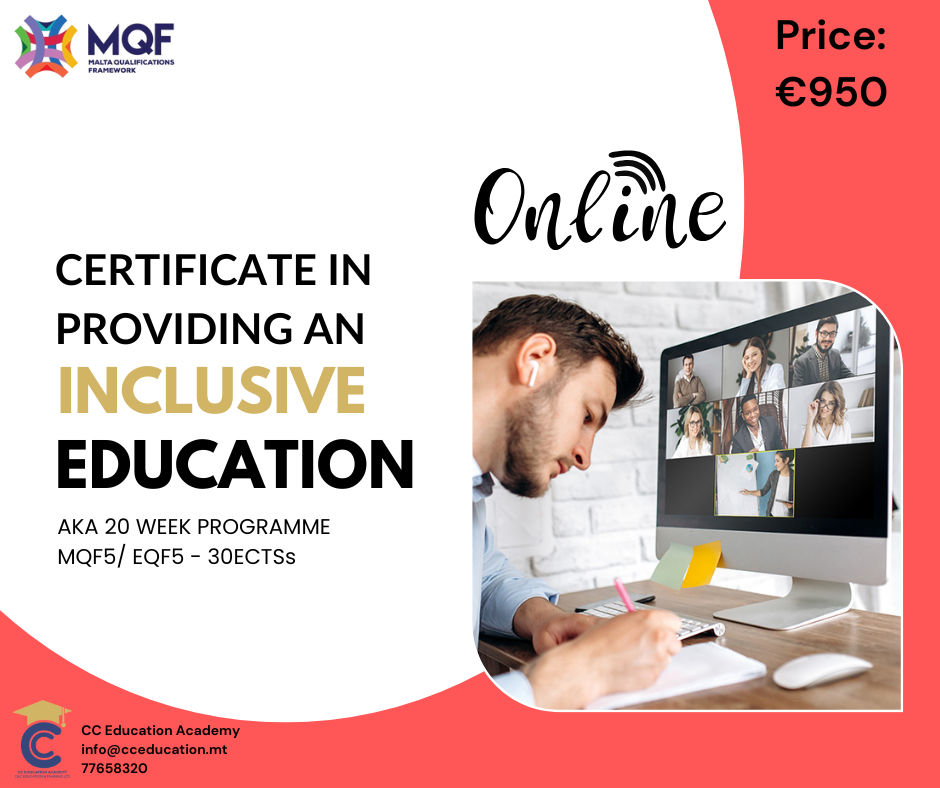
CERTIFICATE IN PROVIDING AN INCLUSIVE EDUCATION MQF 5/EQF 5 - 30ECTS
